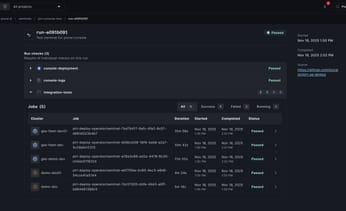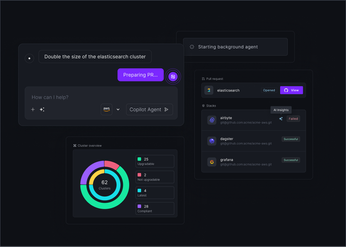
Cilium for Kubernetes: The Ultimate Guide
Learn how Cilium enhances Kubernetes with advanced networking, security, and observability features. Discover its benefits and implementation strategies.
At the heart of modern cloud-native networking is a transformative technology: eBPF (Extended Berkeley Packet Filter). It enables developers to safely run sandboxed programs directly inside the Linux kernel, unlocking unprecedented performance, visibility, and control. Cilium is the leading open-source project that brings the power of eBPF to Kubernetes.
Instead of relying on legacy networking approaches like iptables and kube-proxy, Cilium builds a high-performance, eBPF-based data path that handles networking, security, and observability directly at the kernel level. This architectural shift eliminates bottlenecks, improves scalability, and enables deep application-aware insights that traditional tools can’t match.
In this article, we’ll explore how Cilium integrates with Kubernetes and how it works under the hood. We’ll dive into its core capabilities—ranging from high-throughput load balancing to advanced, identity-aware security policies—and show why Cilium is rapidly becoming the de facto standard for cloud-native networking.
Unified Cloud Orchestration for Kubernetes
Manage Kubernetes at scale through a single, enterprise-ready platform.
Key takeaways:
- Use eBPF for high-performance networking and resilient security: Cilium leverages eBPF to process network traffic directly within the Linux kernel, bypassing slower paths like iptables for better performance. Its identity-based security model decouples policies from ephemeral IP addresses, making your security posture more robust and easier to manage.
- Simplify troubleshooting with integrated observability: Cilium’s built-in tool, Hubble, gives you deep visibility into network traffic and service dependencies. Use it to quickly diagnose connectivity issues, validate policy enforcement, and understand application behavior without needing to deploy separate monitoring agents.
- Standardize deployments to prevent configuration drift at scale: Managing Cilium across a fleet of clusters requires automation to ensure consistency. Use a platform like Plural to define your Cilium configuration as code and apply it uniformly via GitOps, eliminating manual errors and maintaining a secure network posture everywhere.
What Is Cilium and How Does It Enhance Kubernetes?
Cilium is an open-source networking, observability, and security solution built specifically for Kubernetes and other cloud-native platforms. What sets it apart from traditional CNI (Container Network Interface) plugins is its use of eBPF—a powerful Linux kernel technology that enables high-performance, programmable networking without relying on iptables or kube-proxy.
As distributed systems scale, managing secure service-to-service communication becomes increasingly complex. IP-based rules are fragile and hard to maintain in dynamic environments. Cilium solves this by implementing identity-based security policies. Instead of relying on IP addresses, it uses Kubernetes labels to define what services can talk to each other. This results in more reliable and secure communication between microservices, with minimal performance overhead.
While Cilium works well in a single cluster, managing its lifecycle across many clusters can be challenging. Tools like Plural help automate and standardize Cilium deployments fleet-wide, giving platform teams a unified control plane for updates, policy enforcement, and monitoring.
What Is eBPF?
eBPF is a technology that allows safe, sandboxed programs to run directly in the Linux kernel. This enables low-latency packet processing, event monitoring, and policy enforcement—without kernel modifications or performance-killing user space context switches.
Cilium uses eBPF to dynamically insert custom logic into the network stack. Instead of routing traffic through slow, complex chains of iptables rules, Cilium’s eBPF programs intercept and manage traffic as early as possible. This leads to faster throughput, lower CPU usage, and greater visibility.
Want to learn more? See the Cilium GitHub project or the eBPF documentation for a deep dive.
Core Functionalities: Networking, Security, and Observability
Cilium focuses on three key areas:
- Networking: Provides efficient pod-to-pod communication via native routing, tunneling (VXLAN, Geneve), or direct routing. Cilium replaces
kube-proxywith eBPF-based service load balancing for faster, more scalable networking. - Security: Enforces identity-aware network policies across Layers 3–7. Rather than IP-based rules, Cilium lets you define policies like:
“Allow pods labeledapp=backendto accessdbon port 5432.”
This dynamic, label-driven model aligns naturally with Kubernetes. - Observability: Through Hubble, Cilium provides real-time visibility into network flows, service dependencies, and security policy enforcement—critical for debugging and auditing in production environments.
Why Developers Choose Cilium for Kubernetes Networking
Cilium stands out in the Kubernetes networking landscape by using eBPF to deliver fast, secure, and observable networking. Unlike traditional CNI plugins that rely on iptables, Cilium hooks directly into the Linux kernel, enabling low-latency packet processing and dynamic, identity-aware policies that scale with modern microservices.
For platform engineers and SREs running large clusters, these features aren’t just nice-to-haves—they’re critical for performance, security, and debuggability. Let’s look at what makes Cilium worth integrating into your Kubernetes stack.
1. High-Performance Networking via eBPF
Cilium processes packets using eBPF programs that run directly inside the kernel. This bypasses iptables, which can slow down dramatically as rule sets grow. With Cilium, packet filtering, forwarding, and policy enforcement all happen at near-native speed, resulting in:
- Lower latency for east-west traffic
- Higher throughput for microservices communication
- More efficient resource usage across nodes
This is especially useful in high-scale clusters or service meshes with lots of cross-node communication.
2. Identity-Based Security Policies
Instead of writing fragile, IP-based firewall rules, Cilium lets you define policies based on Kubernetes labels. For example:
toEndpoints:
- matchLabels:
app: backend-apiThis means your security rules stay intact even when pods get rescheduled or their IPs change. It’s a major step toward zero-trust networking in Kubernetes, and it scales cleanly across clusters.
With tools like Plural, you can enforce these policies consistently across your fleet—no manual syncing required.
3. Built-in Observability with Hubble
Cilium’s Hubble gives you deep visibility into network flows—down to the HTTP/gRPC/Kafka level. You get:
- Real-time service dependency maps
- L3–L7 flow logs
- CLI and UI tools for inspection and tracing
Whether you're debugging dropped packets or validating network policy changes, Hubble gives you insights iptables-based solutions can't.
Plural's built-in dashboards can complement this with a broader view across your entire platform stack.
4. eBPF-Powered Load Balancing
Cilium replaces kube-proxy with an eBPF-based load balancer, avoiding the performance pitfalls of large iptables chains. Features include:
- Direct Server Return (DSR)
- Maglev hashing for consistent load distribution
- Support for both internal (east-west) and external (north-south) traffic
The result? Faster service routing, fewer moving parts, and better scalability as your services grow.
How Cilium Compares to Other Kubernetes CNIs
When choosing a Container Network Interface (CNI) for Kubernetes, your priorities—performance, security, and observability—will shape the right fit. While options like Calico and Flannel are widely used, Cilium stands out with its eBPF-powered architecture that enables more efficient, secure, and insightful networking.
Cilium vs. Calico vs. Flannel
Cilium embeds networking, security, and observability logic directly into the Linux kernel via eBPF, offering fine-grained control and minimal overhead. It can enforce Layer 3–7 policies and replace kube-proxy for faster service load-balancing.
- Calico uses standard Linux routing and optionally BGP for inter-node communication. It operates at Layer 3 with solid network policy support, but lacks application-layer (L7) policy capabilities unless paired with Envoy.
- Flannel is a lightweight overlay network—great for simple use cases, but it doesn’t support network policies or deep observability.
In short:
| Feature | Cilium | Calico | Flannel |
|---|---|---|---|
| Data plane | eBPF | iptables/ipsets | vxLAN (or host-gw) |
| Policy depth | L3–L7 (identity-based) | L3–L4 (IP-based) | None |
| Observability | Built-in (Hubble) | Limited (w/ 3rd-party) | None |
| kube-proxy | Optional replacement | Required | Required |
For a detailed comparison, see Cilium vs. Calico from Tigera.
When to Choose Cilium
Pick Cilium if your workloads require:
- High-performance networking with minimal CPU overhead.
- Granular security with identity-aware, protocol-level (e.g., HTTP/gRPC) policies.
- Built-in observability, including flow visibility and service dependency graphs via Hubble.
For multi-cluster environments, managing consistency can be tricky. Plural solves this by centralizing configuration and deployment of Cilium across fleets, helping you maintain uniform policies and upgrades at scale.
How to Implement Cilium in a Kubernetes Cluster
Cilium can be installed on a single cluster with a few commands, but deploying and managing it across a fleet of clusters demands a more strategic, automated approach. Factors like network topology, security posture, and scale requirements all influence how you should configure and operate Cilium.
For platform teams, a GitOps-based workflow helps manage this complexity. Tools like Plural enable you to version-control your CNI setup, apply peer-reviewed changes, and roll out updates consistently across clusters.
Installation Overview
The fastest way to get started is with Cilium’s Helm-based installation, which auto-detects your environment and applies a default config. This is ideal for development environments, but for production you'll want a more customized setup.
Key considerations for a production-grade deployment:
- Choose your IPAM mode:
cluster-pool,kubernetes, orenifor AWS. - Enable encryption for pod-to-pod traffic.
- Integrate with cloud-specific networking (e.g., AWS ENI, Azure IPAM).
- Set up Hubble for observability.
- Define your network policies early to avoid retrofitting security later.
Use the Cilium Helm values reference to build a values file tailored to your infrastructure.
Best Practices for Scaling and Optimization
Once deployed, Cilium can be fine-tuned to handle high traffic and complex policies efficiently:
- Follow performance tuning recommendations, including CPU pinning, eBPF map sizing, and enabling XDP acceleration where supported.
- Leverage Cilium’s load balancing and routing features by replacing
kube-proxyfor better performance and visibility. - Use Global Services in Plural to replicate configuration across clusters, avoiding manual drift.
Common Pitfalls and How to Avoid Them
Some common implementation challenges include:
- IP exhaustion in dense clusters. Avoid this by using Cilium’s native IPAM.
- Policy misconfiguration. Test policies with Hubble before enforcing them cluster-wide. Use Hubble UI to inspect traffic flows and troubleshoot dropped connections.
- Operational complexity at scale. Plural provides a unified Kubernetes dashboard and config-as-code automation to simplify monitoring, troubleshooting, and lifecycle management.
Advanced Cilium Use Cases and Integrations
Once Cilium is up and running, you can tap into features that go far beyond basic pod networking. Designed for complex, distributed environments, Cilium’s eBPF-based capabilities simplify multi-cluster communication, streamline service mesh operations, and enforce fine-grained, identity-aware security—all without bolting on extra tooling.
For platform teams managing large Kubernetes fleets, these capabilities aren't just enhancements—they’re essential. They help standardize networking and security across clusters, making operations more scalable, observable, and secure, while freeing developers to ship without dealing with low-level plumbing.
Multi-Cluster Networking with Cluster Mesh
With Cilium Cluster Mesh, you can connect services across multiple Kubernetes clusters as if they were part of the same network. It provides native L3/L4 pod-to-pod connectivity without requiring overlay tunnels, VPNs, or custom gateways.
Services remain discoverable across clusters, and policies continue to be enforced using Cilium’s identity-based model. When managed through a platform like Plural, you can propagate Cluster Mesh configuration and policies fleet-wide using GitOps and Global Services, ensuring consistency with minimal manual effort.
A Lightweight Alternative to Sidecar Service Meshes
Traditional service meshes rely on sidecars like Envoy, which increase latency, consume resources, and complicate observability. Cilium offers a sidecar-free service mesh, handling traffic management and security directly at the kernel level.
It supports features like:
- Transparent L7 policies
- Mutual TLS with WireGuard or IPsec
- Integration with the Kubernetes Gateway API
This model improves performance and reduces ops overhead while preserving full observability through Hubble, Cilium’s real-time traffic inspection layer.
Identity-Aware Network Security
Cilium replaces fragile IP-based rules with identity-based policies tied to Kubernetes labels and metadata. This approach allows you to write portable, declarative policies that apply consistently across clusters and environments.
You can enforce rules based on:
- Service labels
- DNS domains
- HTTP methods, paths, and headers
- gRPC methods
Combined with centralized RBAC management in Plural, you get a strong, zero-trust security posture that adapts as your infrastructure scales.
How to Troubleshoot and Maintain Cilium
Cilium is powerful—but at scale, managing it across multiple clusters can introduce configuration drift, inconsistent policies, and troubleshooting headaches. Issues like broken connectivity, outdated agents, or misconfigured NetworkPolicies can quickly lead to degraded performance or security gaps.
Centralized Management with Plural
Managing Cilium manually on a per-cluster basis doesn’t scale. Plural solves this with GitOps-based automation and a centralized dashboard. Define your Cilium configuration once as code and apply it across your fleet. Eliminate drift, standardize policy enforcement, and access everything securely via a single pane of glass—no juggling kubeconfigs or credentials.
Plural also integrates tools like Hubble, giving you real-time traffic visibility and service dependency maps across all clusters. With built-in role-based access controls, platform teams get secure, auditable observability without compromising developer autonomy.
Diagnose Issues with Confidence
Start with cilium status to check agent health. Use Hubble to trace packet flows, identify dropped connections, or pinpoint which NetworkPolicy is blocking traffic. You can filter by pod, DNS name, or service to quickly isolate the problem—no guesswork, just data.
If you're using Plural, you can access Hubble and other observability tools directly from the embedded Kubernetes dashboard—fully SSO-integrated and scoped by role.
Tune for Performance
Out of the box, Cilium performs well—but tuning unlocks serious gains. Enable kube-proxy replacement to shift service routing into eBPF and bypass iptables/IPVS, improving both latency and CPU efficiency at scale.
Cilium’s performance tuning guide offers cluster-size-specific tweaks. With Plural, you can codify these settings and apply them uniformly through your GitOps workflow.
Monitor and Upgrade Safely
Cilium exports Prometheus metrics covering everything from traffic flows to policy enforcement. Integrate with a stack like Prometheus + Grafana to get actionable alerts and dashboards across clusters. Plural makes this easy by deploying observability tools as a global service, ensuring every cluster stays monitored without extra setup.
For updates, Plural automates version rollouts via PRs with pre-flight checks. This validates new Cilium releases against your current setup before applying changes, reducing the risk of breakage during upgrades.
Related Articles
- Master Kubernetes Networking: A Deep Dive Guide
- Kubernetes CNI: Kubernetes Networking Explained (2025)
- Mastering Multi-Cloud Kubernetes: A Practical Guide
- Runtime Security: Importance, Tools & Best Practices
- Kubernetes Service Mesh: Ultimate Guide (2024)
Unified Cloud Orchestration for Kubernetes
Manage Kubernetes at scale through a single, enterprise-ready platform.
Frequently Asked Questions
What makes eBPF so much faster than traditional networking tools like iptables? Think of eBPF as a more direct route for your network traffic. Traditional tools like iptables force network packets to navigate a long, complex chain of rules within the kernel to figure out where to go. As you add more services and rules, this chain gets longer and slower. eBPF bypasses this entirely by attaching small, efficient programs directly to networking hooks inside the Linux kernel. This allows Cilium to process packets at the earliest possible point, resulting in significantly lower latency and less CPU usage.
Do I have to replace kube-proxy to use Cilium? No, you can run Cilium alongside kube-proxy. However, one of Cilium's most significant performance benefits comes from replacing it. When you enable kube-proxy replacement mode, Cilium uses its own highly efficient, eBPF-based load balancer to handle traffic routing between services. This avoids the performance bottlenecks of kube-proxy, which become more noticeable as your cluster scales and the number of services increases.
Is it difficult to switch to Cilium if we already use a different CNI like Calico or Flannel? The decision to switch depends on your needs. If you only require basic pod-to-pod connectivity, a simpler CNI might be sufficient. However, you should consider moving to Cilium when your requirements evolve. Choose Cilium if you need high-performance networking for demanding workloads, deep observability into application traffic with Hubble, or advanced, identity-based security policies that can inspect traffic at the application layer (L7).
How does Cilium's "identity-based security" work in practice? Cilium assigns a secure identity to your services based on their Kubernetes labels and other metadata, rather than relying on their temporary IP addresses. This allows you to write much more resilient and meaningful security policies. For example, you can create a rule that allows pods with the label app=frontend to make GET requests to the /api/users endpoint of pods labeled app=backend, while blocking all other requests. This policy remains effective even if the pods are restarted and get new IPs.
We manage dozens of clusters. How can we keep our Cilium configurations and network policies consistent everywhere? Managing configurations across many clusters is a common challenge that often leads to security gaps and operational headaches. This is where a platform like Plural becomes essential. By defining your Cilium setup and network policies as code in a Git repository, you can use Plural's GitOps automation to enforce them consistently across your entire fleet. You can define a standard set of security rules once as a Global Service, and Plural will ensure it's deployed and maintained on every cluster, eliminating configuration drift and manual errors.
Newsletter
Join the newsletter to receive the latest updates in your inbox.









